Papers by Gian Paolo Cimellaro
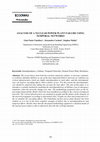
The recent thrust, from both the scientists and policy makers, to increase community resilience i... more The recent thrust, from both the scientists and policy makers, to increase community resilience identifies lifelines as one of the most important field to intervene on. Lifelines are critical infrastructures which are highly interdependent to each other, and this interdependency can lead to cascading effects when a failure occurs. For this reason the interdependencies should be analyzed also taking into account the time effect. The aim of this paper is to introduce a suitable method for modeling the interdependencies of lifelines even in emergency situations, when the networks change over time. The methodology proposed relies on the Input-output Inoperability Model which has been modified according to the criteria of temporal networks. The critical infrastructures are modeled as graphs and the failure of the elements of the network propagates according to determined rules. Graphs are then interconnected in order to simulate the cascading effects. The Fukushima nuclear power plant disaster has been studied, as it is one of the most complete example of failure due to interdependencies and temporal effects. Results show that the developed methodology applied to a detailed model of the nuclear power plant is able to effectively describe the evolving situation.
Lecture notes in civil engineering, 2023
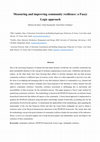
International Journal of Disaster Risk Reduction
Due to the increasing frequency of natural and man-made disasters worldwide, the scientific commu... more Due to the increasing frequency of natural and man-made disasters worldwide, the scientific community has paid considerable attention to the concept of resilience engineering in recent years. Authorities and decisionmakers, on the other hand, have been focusing their efforts to develop strategies that can help increase community resilience to different types of extreme events. Since it is often impossible to prevent every risk, the focus is on adapting and managing risks in ways that minimize impacts to communities (e.g., humans and other systems). Several resilience strategies have been proposed in the literature to reduce disaster risk and improve community resilience. Generally, resilience assessment is challenging due to uncertainty and unavailability of data necessary for the estimation process. This paper proposes a Fuzzy Logic method for quantifying community resilience. The methodology is based on the PEOPLES framework, an indicator-based hierarchical framework that defines all aspects of the community. A fuzzy-based approach is implemented to quantify the PEOPLES indicators using descriptive knowledge instead of hard data, accounting also for the uncertainties involved in the analysis. To demonstrate the applicability of the methodology, data regarding the functionality of the city San Francisco before and after the Loma Prieta earthquake are used to obtain a resilience index of the Physical Infrastructure dimension of the PEOPLES framework. The results show that the methodology can provide good estimates of community resilience despite the uncertainty of the indicators. Hence, it serves as a decision-support tool to help decision-makers and stakeholders assess and improve the resilience of their communities.
arXiv (Cornell University), Feb 19, 2022
In recent years, the concept of resilience has been introduced to the field of engineering as it ... more In recent years, the concept of resilience has been introduced to the field of engineering as it relates to disaster mitigation and management. However, the built environment is only one element that supports community functionality. Maintaining community functionality during and after a disaster, defined as resilience, is influenced by multiple components. This report summarizes the research activities of the first two years of an ongoing collaboration between the

11th National Conference on Earthquake Engineering 2018: Integrating Science, Engineering, and Policy, NCEE 2018, 2018
This paper introduces a new methodology to evaluate the resilience of communities. The methodolog... more This paper introduces a new methodology to evaluate the resilience of communities. The methodology is based on the PEOPLES framework and it makes use of resilience indicators to evaluate community resilience. The methodology requires data for the indicators as input and returns a resilience function as an output. The resilience function shows the serviceability of the community for a given period of time following the disaster. This methodology has been implemented in the form of two software tools. The first one is a web app that is accessible at http://www.resiltronics.org/PEOPLES/login.php or http://borispio.ddns.net/PEOPLES/login.php while the other is a desktop software. The output quality provided by the tools is not compromised with their usage simplicity. Both softwares are meant to assist the user to use the introduced resilience framework by offering a user-friendly interface. As a case study, the resilience of the city of San Francisco city has been evaluated using both tools. ABSTRACT This paper introduces a new methodology to evaluate the resilience of communities. The methodology is based on the PEOPLES framework and it makes use of resilience indicators to evaluate community resilience. The methodology requires data for the indicators as input and returns a resilience function as an output. The resilience function shows the serviceability of the community for a given period of time following the disaster. This methodology has been implemented in the form of two software tools. The first one is a web app that is accessible at http://www.resiltronics.org/PEOPLES/login.php or http://borispio.ddns.net/PEOPLES/login.php while the other is a desktop software. The output quality provided by the tools is not compromised with their usage simplicity. Both softwares are meant to assist the user to use the introduced resilience framework by offering a user-friendly interface. As a case study, the resilience of the city of San Francisco city has been evaluated using both tools.

International Journal of Disaster Risk Reduction, 2022
Community and infrastructure resilience against natural and man-made hazards is paramount for the... more Community and infrastructure resilience against natural and man-made hazards is paramount for the well-being of modern societies. To adapt to the fast-changing world, having communities that can effectively respond to the continuously changing (physical and social) environment is essential. Despite the existing literature on resilience definition and estimation, few frameworks and associated tools can effectively help decision-making. In addition, these tools are usually not well integrated into the community and infrastructure management processes so that decision-makers and authorities can effectively use them. This paper aims at developing a resilience-based risk assessment approach at the community level. It combines the risk analysis parameters with the intrinsic resilience of the community. The proposed approach offers essential insights into the quantitative resilience analysis of communities at different scales and for different natural hazards. It enables the combination of the risk parameters (hazard, exposure, and vulnerability) with the inherent resilience of all the systems that constitute a community. This paper also presents an easy-to-interpret tool for visualizing the resilience results obtained from the introduced approach. It translates the paper's scientific contribution into an interactive and visualization instrument that can ultimately support policymaking to ensure their communities' short and long-term resilience under known and unknown hazardous events.
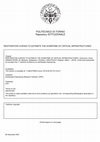
Modeling the performance of critical infrastructures and their interdependencies is an important ... more Modeling the performance of critical infrastructures and their interdependencies is an important task in the resilience assessment. In this paper, restoration curves for four critical lifelines (power, water, gas, telecommunication, and transportation) have been developed using a probabilistic approach. To do that, a large database on infrastructure downtime has been collected for most of the earthquakes that occurred in the past century. The restoration curves have been grouped based on the earthquake magnitude and the level of development of the country in which the earthquake occurred. The curves are presented in terms of probability of recovery and time; the longer is the time after the disaster, the higher is the probability of the infrastructure to recover its functions. PhD Student, Dept. of Civil Structural & Geotechnical Engineering, Politecnico di Torino, Italy, 10129 (email: omar.kammouh@polito.it) PhD Student, Dept. of Civil Structural & Geotechnical Engineering, Politec...
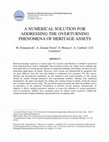
Historical heritage represent a crucial aspect for societies and therefore it should be preserved... more Historical heritage represent a crucial aspect for societies and therefore it should be preserved from natural disasters such as earthquake. Base isolation systems are widely used to mitigate the horizontal effects of strong ground motions on important buildings and bridges, but there are also interesting applications on statues. However, such systems are characterized by properties that are quite different from the ones that belong to traditional civil structures. For this reason, national and international regulations are not exhaustive and actual dynamics of the system should be studied through numerical and experimental methods. Starting from analytical formulations, the paper investigates the sliding and rocking motion in details, being the typical one of statues under seismic loads. The presented numerical model describes the problem and is an alternative to the analytical formulation to perform several analyses automatically. In addition, it allows running parametric analyses...

Infrastructure systems are crucial for the development of communities because they provide essent... more Infrastructure systems are crucial for the development of communities because they provide essential services to the habitants. Here we focus on the transportation network, which is designed to provide a continuous service to the community. Due to its decisive role in the economy, governments and policy makers have been investing in developing strategies to increase the resilience of this kind of infrastructure against disruptive events. In the literature, several methods to evaluate networks’ reliability and resilience can be found. The applicability of these methods is limited to small networks due to the computational complexities. In this paper, the case of city-scale road transportation networks is tackled. The case study considered in this work is the transportation network of a virtual, city called ‘Ideal City’. First, the road map of the city is transformed into an undirected graph with 15012 nodes and 19614 edges. A non-random gradual removal of the edges has been applied until the network’s failure point is reached. The edge removal process is related to the failure probabilities of the edges when the network is exposed to a certain hazard. In fact, the effect of hazards on the transportation network is not direct. The hazard exposes the building structures on the road sides to a failure risk. These structures if collapsed would cause the adjacent roads to be blocked and thus lose functionality due to the debris falling from the structures. For this purpose, a building infrastructure is modeled and the relationship between the level of damage of building and the amount of debris falling on the adjacent roads is developed. A Monte Carlo approach is used to generate failure permutations of edges considering their failure probabilities. The network
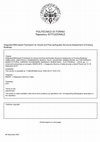
The Italian school buildings asset consists of over 40,000 units. The most (about 60%) were built... more The Italian school buildings asset consists of over 40,000 units. The most (about 60%) were built before the introduction of the national standard on school buildings and constructions in seismic areas. The opportunity to define a methodology to assess the condition of an infrastructure before and after a seismic event is therefore of particular importance, both for a screening of the existing assets and for the damage assessment after the event. Before the event, it may allow to establish priorities of intervention in the field of seismic risk reduction. Furthermore, after the event, it can be crucial to recover the infrastructure. The proposed BIM-based (Building Information Modelling)approach includes static and dynamic non-destructive testing and structural finite element analysis of the existing building. Guidelines for BIM modeling will be drawn up in order to give indications to BIM modelers and to obtain a BIM model that can be straightforward used for dynamic structural ana...
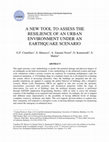
This paper presents a new methodology to predict the potential damage and physical impacts of an ... more This paper presents a new methodology to predict the potential damage and physical impacts of an earthquake on the built environment. A new methodology to the urbanized systems and largescale simulations within a seismic scenario are explored, by evaluating multipurpose codes for numerical simulation. A 3-D building shape of a standard virtual city is developed for evaluating the seismic effects at increasing intensities. Once the buildings are integrated into the city, parallel simulations are applied to compute the global behavior of buildings after a disruptive scenario. Monte Carlo Simulations (MCS) are applied to take into account the epistemic uncertainties associated with geometry and mechanical properties within the range of observations. For each set of buildings’ data, the nonlinear dynamic analysis is performed through SAP2000 Application Programming Interface (API) in order to assess the dynamic response of the buildings in an organized and automatic fashion. Accordingly...

This work aims at establishing laboratory requirements and testing conditions in order to underst... more This work aims at establishing laboratory requirements and testing conditions in order to understand the physical and emotional stability of people during a ground shaking. Several individuals with different human characteristics (gender, age, height, etc.) are considered in the test. Two different laboratory setups are presented. A position device (Kinect) and video targetless tracking algorithm has been used to collect the human body position during the shaking. A two and a three dimensional shaking tables are used to generate artificial earthquakes with different frequency bands. In addition, a well detailed virtual reality setting is applied to the testing site in order to illustrate the real environment. During the experiment, a special attention has been given to the factor of "surprise", which is necessary to ensure a natural reaction of the individuals. The result of the experiment proved common behaviors among the individual samples during the shaking. This work is considered a first step towards a large test campaign, which is necessary to obtain comprehensive statistics on this topic.
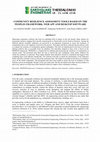
Measuring community resilience has been an exploding field of inquiry in the last decade. Many op... more Measuring community resilience has been an exploding field of inquiry in the last decade. Many options for measuring resilience ranging from specific measurements to frameworks can be found in literature. Among the different options available, indicators are perceived as an important instrument to assess the resilience of communities due to the simplicity involved in the process. This paper introduces indicator-based software tools to compute the resilience of communities against earthquakes. The tools are implemented in the form of web and desktop software that is accessible from any platform. The algorithm adopted in these tools is based on the PEOPLES framework. PEOPLES is a framework for defining and measuring the resilience of communities at various scales. The presented tools allow the user to choose the type community (rural, urban, industry) for which the resilience is measured. These inputs identify what indicators should be considered and suggest what weighting factor each...
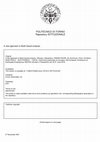
Multi-hazard engineering is increasingly recognized as a serious worldwide concern. In this paper... more Multi-hazard engineering is increasingly recognized as a serious worldwide concern. In this paper, the principle of multi-hazard is applied to an essential steel structure (a hospital) located in California, US. The studied structure is assumed to be exposed to a sequence of three different cascading hazards (earthquake, blast, and fire). First, non-linear time-history analyses are performed and the seismic response of the structure is evaluated. The seismic input is assumed to cause damage to the hospital’s power supply which it turns to generate an explosion. The probability of explosion is estimated accounting for the probabilities of fuel leakage, fuel concentration, and ignition. A set of twelve blast intensity levels is considered in the analysis, corresponding to the different quantity of fuel content inside the tank. Afterward, a fire hazard is generated following the explosion, whose intensity level is evaluated using the compartmental heat flux. The effect of the fire is t...
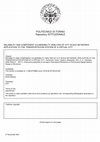
Infrastructure systems are crucial for the development of communities as they provide essential s... more Infrastructure systems are crucial for the development of communities as they provide essential services to the habitants. To improve the resilience of such systems, their intrinsic properties need to be understood and their resilience state needs be identified. In the literature, several methods to evaluate networks’ reliability and resilience can be found. However, the applicability of these methods is restricted to small-size networks due to several computational limitations. In this paper, the case of large scale networks is tackled. The transportation network of a virtual city is considered as a case study. First, the road map of the city is transformed into an undirected graph. A random removal of the roads is applied until the network’s failure point is reached. The network reliability is then calculated using the Destruction Spectrum (D-spectrum) approach. A Monte Carlo approach has been developed to generate failure permutations, which are necessary for the evaluation of th...
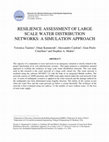
The capacity of a community to react and resist to an emergency situation is strictly related to ... more The capacity of a community to react and resist to an emergency situation is strictly related to the proper functioning of its own infrastructure systems. This paper proposes a simulation oriented approach to evaluate the resilience of large scale water distribution networks. The case study used in this research is the water network of a large scale virtual city. The water network is modeled using the software EPANET 2.0 with the help of an integrated Matlab toolbox. The network consists of 16000 junctions and 19000 water pipes buried under the road network of the city. A series of earthquake scenarios is applied to the water network and the damage induced by the earthquakes has been determined using fragility function. The failure of the system occurs when the water flow and the water pressure go below a certain threshold. The resilience of the network is then evaluated using two indices: (1) the number of users without water, (2) the drop in the total water supply. 1 Department of...






Uploads
Papers by Gian Paolo Cimellaro